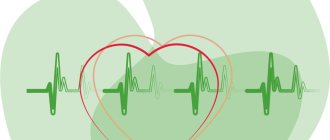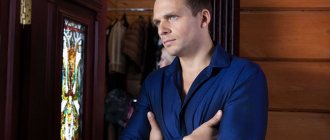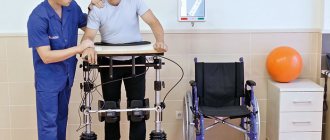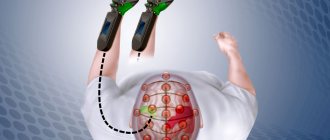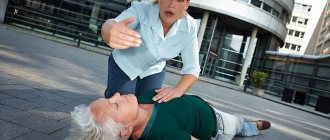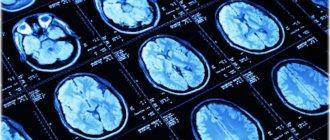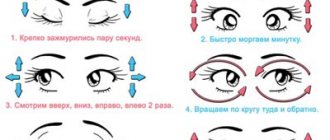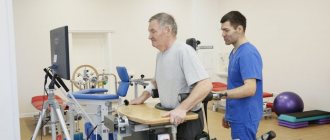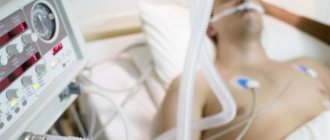Leg after a stroke, what to do - this is what I began to think 10 months after the stroke.
Why?
Firstly, at first I simply couldn’t think because my brain wasn’t working.
Then, I had the task of starting to walk and not lie in bed.
Secondly, when they put me on my feet, that is, I began to move, then my next task was to learn to speak!
First of all, most importantly, I now realized that the situation in general is changing, and with health in particular.
That is, then, I was simply happy when I learned to move independently.
And then, after 10 months, it was no longer enough for me to just move around.
I wanted to walk and move as before, I walked and moved.
Therefore, a leg after a stroke, what to do - this question has its own characteristics during different periods of recovery after a stroke.
Yandex
Read also: NEUROLOGIST AT HOME
Is it possible to restore limb function?
The likelihood of improved health and recovery of the leg after a stroke depends on the nature and severity of the initial deficit. Approximately 35% of patients with initial leg paralysis do not regain useful function. Approximately 20 to 25% of all people who have suffered an episode of acute cerebrovascular accident are unable to walk without physical assistance. If quality rehabilitation is not carried out, six months after a stroke, about 65% of patients cannot include the affected limb in their usual activities. Poor outcomes are possible after an ischemic stroke, when the leg cannot move within two weeks of the crisis. Without adequate rehabilitation measures, only 25% of patients return to their usual level of daily activity and physical functioning.
Improvement in motor function, especially during the first few weeks after stroke, reflects restoration of neurotransmission in the affected tissue near and far from the infarction or hemorrhage. However, at any time after stroke, motor skills may improve through cerebral processes involved in normal learning. This experience-induced and stimulated neuroplasticity involves greater excitability of neurons in both hemispheres of the brain, promoting performance, the sprouting of dendrites that communicate with other nerve cells, and the strengthening of these synaptic connections. Neuroimaging studies demonstrate the evolution of brain activity in both hemispheres as patients' motor skills improve with training and experience.
foot legs
And the best part was that I found out from a rehabilitation specialist that I had serious problems with my foot after a stroke.
That is, I understood why I walked, moving my leg in a semicircle, as if from the side.
I had a foot that would come out on the outside when I moved it while walking.
Then, the rehabilitation specialist prescribed me to wear an orthosis so that my leg could walk correctly.
Of course, I have been doing exercises for my feet since the fall of 2017, but I couldn’t fix my foot.
Consequently, I did not understand why I could not walk normally, that is, move normally.
And only now, three and a half years later, I understood why I couldn’t walk normally!
I couldn't feel my leg and therefore couldn't control its movements.
From the moment I gradually began to feel my leg more and more, I began to try to correct it.
Nerves, nerves and nerves play a very important role in controlling your torso!
Which are connected to the brain!
For example, from the very beginning of recovery, I realized that two components are very important - therapy and exercise therapy, that is, 50% to 50%.
How is the rehabilitation process going?
Rehabilitation and recovery activities are an important part of the treatment process. Rehabilitation measures can be taken:
- in hospital;
- in private rehabilitation centers;
- outpatient;
- at home.
Inpatient rehabilitation during the initial period of recovery is recommended for patients who are unable to return home, but who have sufficient cognitive capacity and fitness to participate in therapy for several hours a day. It is advisable to carry out primary rehabilitation measures in a hospital or rehabilitation centers for those who need constant supervision by nurses and doctors for timely provision of medical care. The most common problem that leads people to inpatient rehabilitation facilities is their inability to walk safely without physical assistance. Approximately 80% of patients undergoing inpatient rehabilitation for 2-4 weeks are discharged to further activities in outpatient settings, private centers and at home.
The assistance provided by experienced, qualified specialists is aimed at developing and implementing an effective rehabilitation program that allows for the restoration of leg function after a stroke in the shortest possible time. An important area of work for rehabilitation specialists is training those directly caring for the victim. Randomized trials show that home caregivers experience more stress, so training caregivers will not only improve their mood and quality of life, but also reduce the financial cost of caring for a stroke victim. Short sessions with relatives help to master special exercises for developing the affected limb, methods for gradually mastering walking, and find the best solutions for managing the patient’s daily activities.
Therapists at specialized centers can supervise and promote this home education aimed at restoring motor function after stroke. Coordinated work by the rehabilitation team, locating community resources such as appropriate transportation and support groups, and timely counseling on sexuality, nutrition, and exercise improve patients' skills in daily living and community participation.
How is leg function restored?
For patients with motor limitations, initial training emphasizes the importance of compensatory strategies. For example, patients learn to transfer from a bed to a wheelchair for mobility, and self-care is performed using an unaffected limb. Recent trials highlight the importance of regular practice of the movements associated with a specific task that gradually increases in difficulty.
To restore the left leg, training in compensatory techniques is required. Performing individual exercises with components of impaired movement of the affected limbs allows you to perform increasingly complex and specific actions over time. First, perform simple exercises in a lying position. An assistant lifts the injured limb above the surface and performs flexion and extension movements. The patient is gradually able to independently perform simple, similar leg movements in a lying and sitting position. At the same time, it is necessary to concentrate on the accuracy, speed and duration of each task.
Restoring walking after a stroke is a primary goal and a reasonable expectation for most patients. Individuals who develop at least partial counter-gravity motion for hip flexion and knee extension will be able to progress over time from single steps between parallel bars to slow walking short distances using a walker or cane. Special plastic ankle and foot orthosis can stabilize weak ankle and knee to improve foot clearance and prevent knee dislocation.
Regaining the ability to walk even short distances requires considerable practice. However, already in the initial stages of rehabilitation, it is necessary to spend at least 15 minutes a day performing mobility tasks. When mastering walking skills, one should strive to increase walking speed to 0.75 m/s, which will eliminate restrictions on movement in the community.
Repeated practice that varies tasks and their requirements is advisable. A simple exercise that can be practiced at home. Ask the victim to go to the shelf, stand on his toes, transfer his body weight to it, and then slowly stand on his foot. Then offer to take books from the top shelf, and, sitting down, put them on the floor, and then return to the bed. Try to practice this exercise for 20 minutes several times a day until your performance is satisfactory.
Improving strength and endurance at home can be achieved by asking a person to perform exercises with a fitness band, gradually introducing variety into the tasks and making them more complex. You can imitate pedaling a bicycle by lying down.
If you have an exercise machine at home, you can walk on a mechanical treadmill. In this case, it is necessary to increase the time of training on the simulator, achieving walking for 30 minutes. It is very important to control the speed of movements, and if shortness of breath occurs, slow down the pace of walking.
It is necessary to gradually introduce activities aimed at performing everyday tasks and meeting the daily needs of the patient and his family. For example, ask the victim to clean mirrors around the house to practice squats, lifts, steps, and balance.
After 6 months, individual goal setting is required. There is a need to improve the skills needed to perform routine household activities and activities outside the home necessary to meet needs. Ask the victim to increase their walking speed and walking distance by 25%. It is advisable to examine commuting conditions and routes to develop strategies that will allow at least limited performance of professional functions.
Randomized trials show that patients who walk slowly (i.e., less than 0.4 m per second) can significantly improve their speed and endurance, even when treatment begins 3 to 12 months after the stroke. Successful interventions include one or more bouts of 10 to 20 hours of targeted exercise over four weeks, such as outdoor walking, treadmill running, obstacle courses, and exercises to improve leg strength and balance. Treadmill training using partial body weight support (attaching a suspension lift to a strap on the patient's chest) allows more steps to be taken at higher speeds than would otherwise be possible.
Patients with hemiparesis have decreased rates of muscle force production, strength, speed of sequential movements, and resistance to fatigue. Although neural factors that influence motor control are responsible for many disorders, changes in muscle fibers and atrophy caused by disuse can contribute negatively. In randomized trials, progressive resistance exercise was performed three to four times per week for a period of 6 to 12 weeks by patients with adequate motor control, improving strength and functional performance. Physical fitness often declines in disabled people, but trials show gains with progressive aerobic exercise. For example, walking on a treadmill three days a week, tailored to each patient's tolerance, even if exercise begins years after the stroke.
Attention to additional and modifiable conditions that may influence the effectiveness of rehabilitation efforts is important and warranted. For example, painful osteoarthritis or heart disease may limit exercise tolerance. Other modifiable factors that limit a person's participation in exercise include sleep disturbances, pain, medication side effects (such as orthostatic hypotension and impaired concentration), mood disorders, and urinary incontinence or retention.
Leg after stroke
I didn’t know how to place my foot correctly, how to move it correctly while walking.
Of course, I did arm and leg exercises on my own every day at home.
And, also, at the Rehabilitation Center I worked out on a bicycle simulator.
But, I moved terribly!
And, most importantly, I began to understand what the problem was.
After 10 months, I noticed that my leg was constantly bent at the knee.
That is, I could not stand exactly on two legs.
Moreover, I could not even move my foot forward while walking.
The joint in the knee did not work, some ligaments did not work, that is, the knee was constantly bent.
Then, I noticed that my hip joint was not working.
Namely, when I tried to move the sore leg forward, the leg moved along with the “basin”.
I realized that the largest hip joint does not work!
That is, his movements do not allow me to move my leg forward and backward freely.
Consequently, I discovered that I had even more peculiarities with my leg movements.

